|
|
 |
Fiche d'espèce de Copépode |
|
|
Cyclopoida ( Ordre ) |
|
|
|
Oncaeidae ( Famille ) |
|
|
|
Oncaea ( Genre ) |
|
|
| |
Oncaea mediterranea (Claus, 1863) (F,M) | |
| | | | | | | Syn.: | Antaria mediterranea Claus, 1863 (p.159, figs.F,M);
Oncäa mediterranea : Giesbrecht, 1892 (p.591, 602, 774, figs.F,M);
O. mediterranea var. flava : Giesbrecht, 1892 (p.592, pl.4 & 47, figs.F);
no Oncaea mediterranea : Bourne, 1889 (p.151, figs.F); T. Scott, 1894 b (p.117); | | | | Ref.: | | | Bourne, 1889 (p.151, figs.F, Rem.); Thompson & Scott, 1903 (p.239, 284); Farran, 1908 b (p.92); Wolfenden, 1911 (p.362); Pesta, 1920 (p.651, fig.); Farran, 1926 (p.297); 1929 (p.210, 285); Rose, 1929 (p.57); 1933 a (p.297, figs.F,M); Farran, 1936 a (p.126); Dakin & Colefax, 1940 (p.116, figs.F); Lysholm & al., 1945 (p.43); Sewell, 1947 (p.262); Vervoort, 1957 (p.147); Owre & Foyo, 1967 (p.111, figs.F,M); Vilela, 1968 (p.31); Corral Estrada, 1970 (p.217, Rem.); Björnberg, 1972 (p.92, Rem. N); Razouls, 1972 (p.95, Annexe: p.112, figs.F,M); Bradford, 1972 (p.50, figs.F,M) ; Kos, 1972 (Vol. I, figs.F, M, Rem.); Razouls, 1974 b (p.237, figs.F, non M); Chen & al., 1974 (p.42, figs.F); Ferrari, 1975 (p.222, figs.F,M, Rem.); Heron, 1977 (p.51, figs.F); Boxshall, 1977 a (p.128, figs.F,M); Dawson & Knatz, 1980 (p.9, 10, figs.F,M); Björnberg & al., 1981 (p.667, figs.F,M); Marques, 1982 (p.772); Malt, 1983 a (p.6, figs.F, Rem.); Heron & Bradford-Grieve, 1995 (p.32, figs.F,M); Chihara & Murano, 1997 (p.980, Pl.222: F,M, Rem.); Böttger-Schnack & Huys, 1997 (p.137, Redesc. F,M, figs.F,M, Rem.); Boxshall, 1998 (p.226); Bradford-Grieve & al., 1999 (p.887, 970, figs.F,M); Böttger-Schnack, 2001 (p.53, figs.F, Rem.: corrective note); Conway & al., 2003 (p.223, figs.F,M, Rem.); Böttger-Schnack & al., 2004 (p.1130, tab.1, Rem.); Avancini & al., 2006 (p.136, Pl. 104, figs.F,M, Rem.); Wi & al., 2009 (p.96, figs.F,M, Rem.); Vives & Shmeleva, 2010 (p.292, figs.F,M, Rem.); Böttger-Schnack & Machida, 2011 (p.111, Table 1, 2, fig.2, 3, DNA sequences, phylogeny); Böttger-Schnack & Schnack, 2013 (p.4: Table 1, Rem.: s.str-Group) | 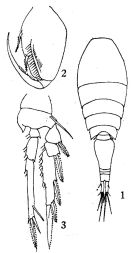 issued from : Q.-c Chen & S.-z. Zhang & C.-s. Zhu in Studia Marina Sinica, 1974, 9. [Pl.7, Figs.1-3]. Female (from China Seas): 1, habitus (dorsal); 2, Mxp; 3, P4.
|
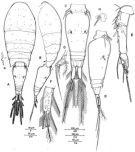 issued from : R. Böttger-Schnack & R. Huys in Bull. nat. Hist. Mus. Lond. (Zool.), 1997, 63 (2). [p.139, Fig.1]. Female (from Red Sea): A, habitus (dorsal) [a, lateral raised pore, enlarged]; B, idem (lateral left side (appendages omitted); arrow indicating position of lateral raised pore; C, urosome (dorsal); D, idem (lateral); E, A1; F, caudal ramus (dorsal); G, P5 (dorsal); H, P6. Nota: Proportional lengths (%) of urosomites and caudal rami 8.1: 50.7: 6.8: 7.3: 10.5: 16.5. Anal somite 1.3 times wider than long; about 2/3 the length of caudal rami. Caudal ramus about 3.0 times as long as wide. A1 6-segmented, relative lengths (%) of segments measured along posterior non-setiferous margin 6.2: 20.6: 46.4: 10.3: 6.2: 10.3.
|
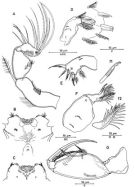 issued from : R. Böttger-Schnack & R. Huys in Bull. nat. Hist. Mus. Lond. (Zool.), 1997, 63 (2). [p.140, Fig.2]. Female: A, A2; B, labrum (anterior); C, idem (posterior); D, Md (showing individual elements); E, Mx1; F, Mx2 [f1, distal seta; f2, proximal seta]; G, Mxp.
|
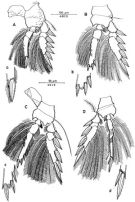 issued from : R. Böttger-Schnack & R. Huys in Bull. nat. Hist. Mus. Lond. (Zool.), 1997, 63 (2). [p.141, Fig.3]. Female: A, P1 (anterior) [a, terminal part of endopod]; B, P2 (anterior) [b, terminal part of endopod]; C, P3 (postrior) [c, terminal part of endopod]; D, P4 (anterior) [d, terminal part of endopod].
|
 issued from : R. Böttger-Schnack & R. Huys in Bull. nat. Hist. Mus. Lond. (Zool.), 1997, 63 (2). [p.145, Fig.5]. Female (from eastern Mediterranean), broad form: A, habitus (dorsal); B, idem (lateral right side); C, caudal ramus.
|
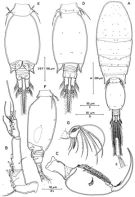 issued from : R. Böttger-Schnack & R. Huys in Bull. nat. Hist. Mus. Lond. (Zool.), 1997, 63 (2). [p.143, Fig.4]. Male (from Red Sea): A, habitus (dorsal); B, A1; C, Mxp (anterior) [c, tip of claw, showing hyaline lamella]; D, urosome (dorsal); E, idem (ventral); F, idem (lateral), with spematophore immature; G, A2 (distal endopod segment). Nota: Proportional lengths (%) of urosomites (caudal rami included) 8.4:62.1: 3.0: 3.3: 2.7:8.1: 11.6. Caudal rami 1.8 times longer than wide, markedly shorther than in female. P1-4 with armature as in female; variable number of spinules on conical projection of endopods of P2 and P3.
|
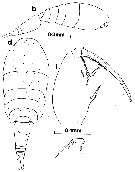 issued from : G.A. Boxshall in Brit. Mus. nat. Hist., Zool., 1977, 31 (3). [p.125, Fig.11, b, d, i, j]. Female (18°N, 25°W): b, habitus (lateral); d, idem (dorsal); i, Mxp (posterior; j, P5 (dorsal). Nota: Prosome not strongly vaulted; body not giving an arched appearance from the lateral aspect. Genital complex about 1.2 times longer than rest of urosome and sides tapering posteriorly. Caudal rami 2.4 times longer than anal somite and 4.0 to 4.5 times longer than broad. P5 (more elongate than in O. venusta) 2.3 to 2.5 times longer than broad and with 1 long apical seta and 1 short subapical seta.
|
 issued from : G.A. Boxshall in Brit. Mus. nat. Hist., Zool., 1977, 31 (3). [p.126, Fig.12, e-h]. Male: e, urosome (ventral); f, A2 (anterior); g, Mx1 (posterior); h, Mxp (anterior). Nota: caudal rami 1.4 times longer than the anal somite and about 2.8 times longer than broad. Mx1 with the outermost seta on the outer lobe well developed and bearing a row of fine spinules.
|
 issued from : G.C. Bourne in J. Mar. biol. Ass. U.K., 1889, n. ser. 1. [Pl.XII]. Female (from Plymouth): 1, A1; 2, one of the swimming foot; 3,Mxp; 4, Mx1; 5, urosomal segments; 6, Mx2; 7, A2.
|
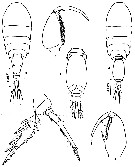 issued from : Z. Zheng, S. Li, S.J. Li & B. Chen in Marine planktonic copepods in Chinese waters. Shanghai Sc. Techn. Press, 1982 [p.102, Fig.60]. Female: a, habitus (dorsal); b, Mxp; c, P4. Male: d, habitus (dorsal); e, urosome (ventral); f, Mxp. Scale bar in mm.
|
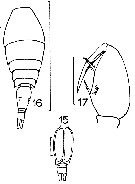 issued from : J.M. Bradford in Mem. N. Z. Oceonogr. Inst., 1972, 54. [p.52, Fig.15, (15-17]. Female (from Kaikoura, New Zealand): 16, habitus (dorsal); 17, Mxp. Male: 15, abdomen. Scale bars: 1 mm (16): 0.1 mm (15, 17).
|
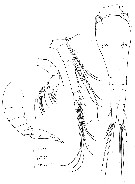 issued from : G.A. Heron in Antarct. Res. Ser. Washington, 1977, 26. [p.52, Fig.8, e-h]. Female: e, habitus (lateral (scale bar: X); f, urosome (dorsal; scale bar: Y); g, left A1 (scale bar: Y); h, left A2 (scale bar: Y).
|
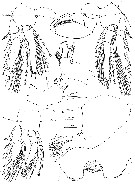 issued from : G.A. Heron in Antarct. Res. Ser. Washington, 1977, 26. [p.53, Fig.9]. Female: a, labrum (scale bar: Z); b, right Md (scale bar: Z); c, left Mx1 (scale bar: Z); d, left Mx2 (scale bar: Z); e, right Mxp (scale bar: Y); f-h, P2 to P3 (scale bar: Y).
|
 issued from : G.A. Heron in Antarct. Res. Ser. Washington, 1977, 26. [p.54, Fig.10, a-b]. Female: a, P4 (scale bar: Y); b, P5 (scale bar: Z).
|
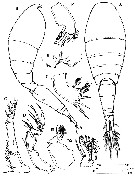 issued from : J.H. Wi, Y.H. Yoon & H.Y. Soh in Ocean Sci. J., 2009, 44 (2). [p.97, Fig.2]. Female (from Korea Strait): A-B, habitus (dorsal and lateral, respectively); C, A1; D, A2; E, labrum (posterior); F, Md; G, Mx1; H, Mx2. Scale bars in micrometers.
|
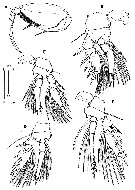 issued from : J.H. Wi, Y.H. Yoon & H.Y. Soh in Ocean Sci. J., 2009, 44 (2). [p.99, Fig.3]. Female: A, Mxp; B-E, P1 to P4, respectively . Scale bars in micrometers.
|
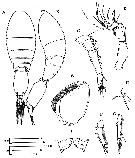 issued from : J.H. Wi, Y.H. Yoon & H.Y. Soh in Ocean Sci. J., 2009, 44 (2). [p.100, Fig.4]. Male: A-B, habitus (dorsal and lateral, respectively); C, A1; D, A2; E, Mxp; F, endopodite 3 of P1; G, endopodite 3 of P4; H, P5; I, P6 (represented by posterolateral flap closing off genital aperture on either side; covered by rows of minute denticles; posterlateral corners protruded into pointed tip) Scale bars in micrometers..
|
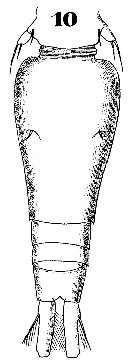 Issued from : W. Giesbrecht in Systematik und Faunistik der Pelagischen Copepoden des Golfes von Neapel und der angrenzenden Meeres-Abschnitte. – Fauna Flora Golf. Neapel, 1892, 19 , Atlas von 54 Tafeln. [Taf.47, Fig.10]. As Oncäa mediterranea var. flava. Female: 10, urosome (dorsal).
|
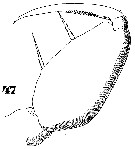 Issued from : W. Giesbrecht in Systematik und Faunistik der Pelagischen Copepoden des Golfes von Neapel und der angrenzenden Meeres-Abschnitte. – Fauna Flora Golf. Neapel, 1892, 19 , Atlas von 54 Tafeln. [Taf.47, Fig.47]. As Oncäa mediterranea var. flava. Female: 47, Mxp.
|
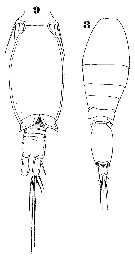 Issued from : W. Giesbrecht in Systematik und Faunistik der Pelagischen Copepoden des Golfes von Neapel und der angrenzenden Meeres-Abschnitte. – Fauna Flora Golf. Neapel, 1892, 19 , Atlas von 54 Tafeln. [Taf.47, Figs.8, 9]. As Oncäa mediterranea var. flava. Male: 8, habitus (dorsal); 9, urosome (ventral).
|
 issued from : C. Razouls in Th. Doc. Etat Fac. Sc. Paris VI, 1972, Annexe. [Fig.68]. Female (from Banyuls, G. of Lion): A, urosome; B, Mxp; C, A2; D, P2; E, P4; F,P1; G, P3.
|
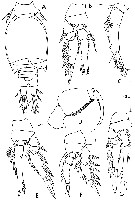 issued from : C. Razouls in Th. Doc. Etat Fac. Sc. Paris VI, 1972, Annexe. [Fig.69]. Male: A, urosome; B, P2; C, A1; D, Mxp; E, P3; F, P1; G, P4.
|
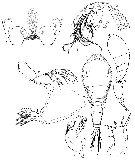 Issued from : G.A. Heron & J.M. Bradford-Grieve in New Zealand Iceanogr. Inst.. Memoir 104. NIWA, 1995. [p.34, Fig.14, e-l]. Female (from SW Pacific): e, habitus (lateral) [q]; f, same (dorsal) [q]; g, anterior of prosome (ventral) [r]; h, right A2 [s]; i, labrum (ventral) [u]; j, right Md [u]; k, left Mx1 [u]; l, right Mx2 [w]. Scale bars: See p.13, fig.2. Letter in brackets.
|
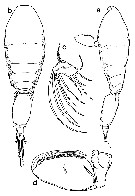 issued from : G.A. Heron & J.M. Bradford-Grieve in New Zealand Oceanogr. Inst. memoir 104. NIWA, 1995. [p.34, Fig.14, a-d]. Male (from SW Pacific): a, habitus (lateral and dorsal, respectively) [q]; c, 3rd segment of right A2 [s]; d, left Mxp [v]. Scale bars: See p.13, fig.2. Letter in brackets.
| | | | | Ref. compl.: | | | Mrazek, 1902 (p.524); Cleve, 1904 a (p.193); Pearson, 1906 (p.35); Carazzi & Grandori, 1912 (p.13, 38); Rose, 1925 (p.152); Wilson, 1942 a (p.198); Sewell, 1948 (p.346, 461, 515); Fleury, 1950 (p.47, fig.2); Fagetti, 1962 (p.43); V.N. Greze, 1963 a (tabl.2); Shmeleva, 1963 (p.141); Duran, 1963 (p.25); Giron-Reguer, 1963 (p.58); Gaudy, 1963 (p.31, Rem.); ? Björnberg, 1963 (p.79, Rem.); Unterüberbacher, 1964 (p.34); De Decker, 1964 (p.16, 23, 29); De Decker & Mombeck, 1964 (p.13); Pavlova, 1964 (p.1710); Shmeleva, 1965 b (p.1350, lengths-volume-weight relation); Pavlova, 1966 (p.45); Furuhashi, 1966 a (p.295, vertical distribution in Kuroshio region, Table 9);Neto & Paiva, 1966 (p.31, Table III, annual cycle); Mazza, 1966 (p.73); 1967 (p.365); Ehrhardt, 1967 (p.743, geographic distribution, Rem.); Séguin, 1968 (p.488); Evans, 1968 (p.14); Delalo, 1968 (p.139); Dowidar & El-Maghraby, 1970 (p.269); Kovalev, 1970 (p.91, Tableau 1, 2, fig., egg production); Deevey, 1971 (p.224); Bainbridge, 1972 (p.61, Appendix Table I: vertical distribution vs day/night, Table II: %); Binet & al., 1972 (p.68, 73); Apostolopoulou, 1972 (p.329, 377, fig.10); Björnberg, 1973 (p.364, 388); Corral Estrada & Pereiro Muñoz, 1974 (tab.I); Peterson & Miller, 1975 (p.642, 650, occurrence); Vives & al., 1975 (p.56, tab.II); Peterson & Miller, 1976 (p.14, Table 1, 2, 3, abundance vs interannual variations); Zalkina, 1977 (p.339, tab.1); Boxshall, 1977 b (p.548); Deevey & Brooks, 1977 (p.156, tab.2, Station "S"); Peterson & Miller, 1977 (p.717, Table 1, seasonal occurrence); Frontier, 1977 a (p.17); Dessier, 1979 (p.134, 202, 207); Porumb, 1980 (p.168); Vaissière & Séguin, 1980 (p.23, tab.1); Vives, 1982 (p.295); Kovalev & Shmeleva, 1982 (p.85); Rudyakov, 1982 (p.208, Table 2); Dessier, 1983 (p.89, Tableau 1, 2, Rem., %); Turner & Dagg, 1983 (p.17, 22); Moore E.A. & Sander, 1983 (p.113, fig.1: variation % sex ratio); Scotto di Carlo & Ianora, 1983 (p.150); Scotto di Carlo & al., 1984 (p.1041); Guangshan & Honglin, 1984 (p.118, tab.); Moraitou-Apostolopoulou, 1985 (p.303, occurrence/abundance in E Mediterranean Sea, Rem.: p.310); Regner, 1985 (p.11, Rem.: p.40); Jansa, 1985 (p.108, Tabl.I, II, III); Longhurst, 1985 (tab.2); M. Lefèvre, 1986 (p.33); Lozano Soldevilla & al., 1988 (p.61); Dessier, 1988 (tabl.1); Böttger-Schnack & al., 1989 (p.1089); Hirakawa & al., 1990 (tab.3); Yoo, 1991 (tab.1); Hirakawa, 1991 (p.376: fig.2); Scotto di Carlo & al., 1991 (p.270); Paffenhöfer, 1993 (p.37, egg production); Böttger-Schnack, 1994 (p.277); 1995 (p.92); Shih & Young, 1995 (p.77); Hajderi, 1995 (p.542); Webber& Roff, 1995 a (p.481, Table 2, 3, 6, 8, biomass, production); Böttger-Schnack, 1996 (p.1086); Kotani al., 1996 (tab.2); Paffenhöfer & al., 1996 (p.1699, motion behavior); Webber & al., 1996 (tab.1); Ohtsuka & al., 1996 a (p.91); Böttger-Schnack, 1997 (p.409); Suarez-Morales & Gasca, 1997 (p.1525); Noda & al., 1998 (p.55, Table 3, occurrence); Hure & Krsinic, 1998 (p.85, 104); Krsinic, 1998 (p.1051); Hopcroft & al., 1998 (tab.2); Alvarez-Cadena & al., 1998 (t.1,2,3,4); Suarez-Morales & Gasca, 1998 a (p.112); Go & al., 1998 (p.475, Table 1, feeding behavior); Lapernat, 1999 (p.36); Siokou-Frangou, 1999 (p.479); Dolganova & al., 1999 (p.13, tab.1); Lavaniegos & Gonzalez-Navarro, 1999 (p.239, Appx.1); Harvey & al., 1999 (p.1, 49: Appendix 5, in ballast water vessel); Razouls & al., 2000 (p.343, Appendix); Ueda & al., 2000 (tab.1); Musaeva & Gagarin, 2000 (p.534, tab.1); Seridji & Hafferssas, 2000 (tab.1); Moraitou-Apostolopoulou & al., 2000 (tab.I, fig.6); Lapernat & Razouls, 2001 (tab.1); Böttger-Schnack & al., 2001 (p.1029, tab.1, 2); Krsinic & Grbec, 2002 (p.127, tab.1); Zerouali & Melhaoui, 2002 (p.91, Tableau I); Gaudy & al., 2003 (p.357, tab.1); Fernandez de Puelles & al., 2003 (p.123, fig.5); Vukanic, 2003 (p.139, tab.1); Hwang & al., 2003 (p.193, tab.2); Hsieh & al., 2004 (p.398, tab.1, p.399, tab.2); Daly Yahia & al., 2004 (p.366, fig.4); Lan & al., 2004 (p.332, tab.1); Lo & al.*, 2004 (p.218, fig.6); Nishibe & Ikeda, 2004 (p.931, Tab. 2, 5); Lo & al., 2004 (p.89, tab.1); Vukanic & Vukanic, 2004 (p.9, tab. 2, 3); Camisotti & al., 2005 (p.99); Prusova & Smith, 2005 (p.76); Zuo & al., 2006 (p.164: tab.1, 3,abundance, fig.8: stations group); Isari & al., 2006 (p.241, tab.II); Lavaniegos & Jiménez-Pérez, 2006 (tab.2, Rem.); Hwang & al., 2006 (p.943, tabl. I); Zervoudaki & al., 2006 (p.149, Table I); Hwang & al., 2007 (p.25); Fernandez de Puelles & al., 2007 (p.340: fig.7); Valdés & al., 2007 (p.104: tab.1); Khelifi-Touhami & al., 2007 (p.327, Table 1); McKinnon & al., 2008 (p.844: Tab.1); Morales-Ramirez & Suarez-Morales, 2008 (p.516, 525); Tseng L.-C. & al., 2008 (p.46, table 2, abundance vs moonsons); Ohtsuka & al., 2008 (p.115, Table 4, 5, Rem.: in Kawasaki Harbor); Raybaud & al., 2008 (p.1765, Table A1); Pagano, 2009 (p.116); Miyashita & al., 2009 (p.815, Tabl.II); Chiba & al., 2009 (p.1846, Table 1, occurrence vs temperature change); Böttger-Schnack & Schnack, 2009 (p.131, Table 3, 4, Rem.); Licandro & Icardi, 2009 (p.17, Table 4); Lan Y.-C. & al., 2009 (p.1, Table 2, % vs hydrogaphic conditions); Nishibe & al., 2009 (p. 491, Table 1: seasonal abundance); Brugnano & al., 2010 (p.312, Table 3, fig.8); Lidvanov & al., 2010 (p.356, Table 3); Drira & al., 2010 (p.145, Tanl.2); Hidalgo & al., 2010 (p.2089, Table 2); Mazzocchi & Di Capua, 2010 (p.429); Medellin-Mora & Navas S., 2010 (p.265, Tab. 2); Dvoretsky & Dvoretsky, 2010 (p.991, Table 2); Xu & Gao, 2011 (p.514, figs.3, 4, Table 2: optimal salinity); Tseng L.-C. & al., 2011 (p.47, Table 2, occurrences vs mesh sizes); Hsiao S.H. & al., 2011 (p.475, Appendix I); Hsiao & al., 2011 (p.317, Table 2, indicator of seasonal change); Kâ & Hwang, 2011 (p.155, Table 3: occurrence %); Isari & al., 2011 (p.51, Table 2, abundance vs distribution); Andersen N.G. & al., 2011 (p.71, Fig.3: abundance); Selifonova, 2011 a (p.77, Table 1, alien species in Black Sea); Shiganova & al., 2012 (p.61, Table 4); Uysal & Shmeleva, 2012 (p.909, Table I); Brugnano & al., 2012 (p.207, Table 2, 3); Salah S. & al., 2012 (p.155, Tableau 1); DiBacco & al., 2012 (p.483, Table S1, ballast water transport); Dorgham & al., 2012 (p.473, Table 3: abundance %); Jang M.-C & al., 2012 (p.37, abundance and seasonal distribution); Rekik & al., 2012 (p.336, Table 1, abundabce); Gubanova & al., 2013 (in press, p.4, Table 2); Belmonte & al., 2013 (p.222, Table 2, abundance vs stations); Tachibana & al., 2013 (p.545, Table 1, seasonal change 2006-2008); Sano & al., 2013 (p.11, Table 2, feeding habits); Tseng & al., 2013 a (p.1, Table 3, 4, abundance); Lidvanov & al., 2013 (p.290, Table 2, % composition); Hwang & al., 2014 (p.43, Appendix A: seasonal abundance); Pansera & al., 2014 (p.221, Table 2, abundance); Zaafa & al., 2014 (p.67, Table I, occurrence); Mazzocchi & al., 2014 (p.64, Table 3, 4, 5, spatial & seasonal composition %); Fierro Gonzalvez, 2014 (p.1, Tab. 3, 4, 5, occurrence, abundance); Zakaria & al., 2016 (p.1, Table 1, 3); Benedetti & al., 2016 (p.159, Table I, fig.1, functional characters); Ben Ltaief & al., 2017 (p.1, Table III, Summer relative abundance); Marques-Rojas & Zoppi de Roa, 2017 (p.495, Table 1); El Arraj & al., 2017 (p.272, table 2); Benedetti & al., 2018 (p.1, Fig.2: ecological functional group); Chaouadi & Hafferssas, 2018 (p.913, Table II: occurrence); Palomares-Garcia & al., 2018 (p.178, Table 1: occurrence); Hirai & al., 2020 (p.1, Fig. 5: cluster analysis (OTU), spatial distribution). | | | | NZ: | 20 | | |
|
Carte de distribution de Oncaea mediterranea par zones géographiques
|
| | | | | | | | | | | | | | | | | | 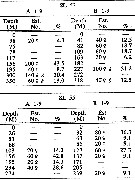 issued from : H.B. Owre & M. Foyo in Fauna Caribaea, 1, Crustacea, 1: Copepoda. Copepods of the Florida Current. 1967. [p.112, Table 55]. issued from : H.B. Owre & M. Foyo in Fauna Caribaea, 1, Crustacea, 1: Copepoda. Copepods of the Florida Current. 1967. [p.112, Table 55].
Vertical distribution of Oncaea mediyrttanea at thje "40-Mile Station'' in the Florida Current (± 25°35'N, 79°27'W).
SL 53: 18 V 1958; SL 55: 21 VII 1858; A: during midday; B: during midnight. |
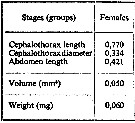 issued from : A.A. Shmeleva in Bull. Inst. Oceanogr., Monaco, 1965, 65 (n°1351). [Table 6: 42]. Oncaea mediterranea (from South Adriatic). issued from : A.A. Shmeleva in Bull. Inst. Oceanogr., Monaco, 1965, 65 (n°1351). [Table 6: 42]. Oncaea mediterranea (from South Adriatic).
Dimensions, volume and Weight wet. Means for 50-60 specimens. Volume and weight calculated by geometrical method. Assumed that the specific gravity of the Copepod body is equal to 1, then the volume will correspond to the weight. |
 issued from : A.V. Kovalev in Gidrobiol. Zh., 1970,
6 (5). [p.92, Table 1]. issued from : A.V. Kovalev in Gidrobiol. Zh., 1970,
6 (5). [p.92, Table 1].
Relation between the body length of females and number of eggs.
A: species; B: number of females; C: length of females in mm; D: number of eggs in relation to the lengths of females. |
| | | | Loc: | | | Cosmopolite (tropical, sub-tropical), Also: sub-Antarct. (Indian, SW Pacif., exceptional), Faroe Is., Barents Sea, Mediterranean Sea, Thracian Sea, W Egyptian coast, Black Sea, Red Sea (G. of Aqaba, off Sharm El-Sheikh, N-S), S Korea, Cheju Island, China Seas (Yellow Sea, East China Sea, South China Sea), Taiwan Strait, Taiwan, Korea Strait, Japan (Kuchinoerabu Is., Tosa Bay, Sagami Bay, Tokyo Bay), Kuroshio & Oyashio regions, Chile (N-S) | | | | N: | 280 | | | | Lg.: | | | (34) F: 1,25-0,98; (35) F: 1,36-1,12 [Atlant.]; F: 1,32-1,25 [N-Z]; F: 1,18-1,17 [54° S]; (38) F: 1,6-1,3; M: 1,12-1,02; (46) F: 1,3-1; M: 0,95-0,9; (104) F: 1,1; (109) F: 1,4-1,3; (116) F: 1,12; (139) F: 1,35-0,98; M: 1,08-0,96; (180) F: 1,25-1,18; M: 1,03-0,8; (327) F: 1,39-0,98; M: 0,94-0,8; (332) F: 1,34-1,31; M: 1,07-0,81; (340) F: 1,2-1; (432) F: 1,45-1,32; (449) F: 1,3-1; M: 1,05-0,7; (679) F: 1,25-1,13; (687) [G1] F: 1,22-1,07; M: 0,89-0,76; [G2] F: 1,37-1,29; M: 1,12-1,06; [G3] F: 0,91-0,85; M: 0,75-0,69; (693) F: 1,4; M: 0,96; (786) F: 1,33; (788) F: 1,03-0,9; M: 0,78-0,7; 0,9; (920) F: 1,07; (991) F: 1-1,3; M: 0,7-1,05; (1023) F: 1,22-1,42; M: 0,7-1,12; (1072)* F: 1,2-1,28; M: 0,74-0,83; (1101) F: 0,91-1,20; {F: 0,85-1,60; M: 0,69-1,12}
*: Body length in lateral aspect. | | | | Rem.: | épi à mésopélagique, (off Malte: 3000 m).
Sampling depth ( sub-Antarct.) : 0-1000 m.
Sa distribution et son origine semblent comparables à O. media comme l'avait remarqué Giesbrecht (1892, p.592).
Voir aussi les remarques en anglais | | | Dernière mise à jour : 21/10/2022 | |
|
|
 Toute utilisation de ce site pour une publication sera mentionnée avec la référence suivante : Toute utilisation de ce site pour une publication sera mentionnée avec la référence suivante :
Razouls C., Desreumaux N., Kouwenberg J. et de Bovée F., 2005-2025. - Biodiversité des Copépodes planctoniques marins (morphologie, répartition géographique et données biologiques). Sorbonne Université, CNRS. Disponible sur http://copepodes.obs-banyuls.fr [Accédé le 03 décembre 2025] © copyright 2005-2025 Sorbonne Université, CNRS
|
|
 |
 |





























